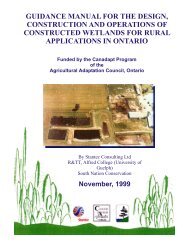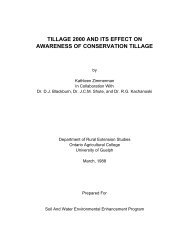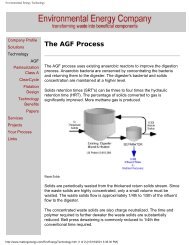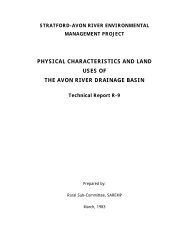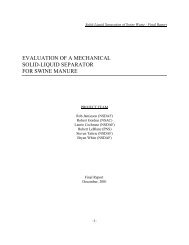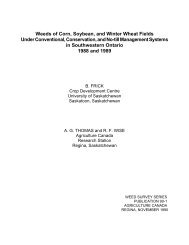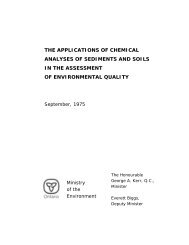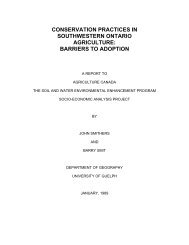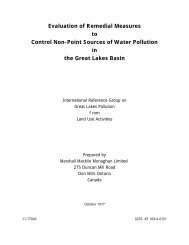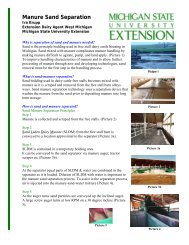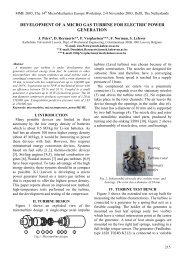Environmental Aspects of Phosphate and Potash Mining United ...
Environmental Aspects of Phosphate and Potash Mining United ...
Environmental Aspects of Phosphate and Potash Mining United ...
You also want an ePaper? Increase the reach of your titles
YUMPU automatically turns print PDFs into web optimized ePapers that Google loves.
The <strong>Environmental</strong> Approach <strong>of</strong> the <strong>Phosphate</strong> Rock <strong>and</strong> <strong>Potash</strong> <strong>Mining</strong> Industry<br />
Solid Waste Disposal <strong>and</strong> Water Management System with Performance Feedback<br />
34<br />
The Tapira mining <strong>and</strong> beneficiation complex is located<br />
in the state <strong>of</strong> Minas Gerais, Brazil <strong>and</strong> owned <strong>and</strong> operated<br />
by Fertilizantes Fosfatados S.A. (Fosfertil).<br />
<strong>Phosphate</strong> rock is extracted from an igneous deposit<br />
using an open-cut truck <strong>and</strong> shovel mining method.<br />
Annual production is around 11 million tonnes <strong>of</strong> ore<br />
per year. The phosphate ore is concentrated in the beneficiation<br />
plant before transport through a slurry<br />
pipeline to the Uberaba fertilizer processing complex.<br />
The waste disposal <strong>and</strong> water management system<br />
consists <strong>of</strong> five dams in total, three <strong>of</strong> which are used for<br />
waste storage <strong>and</strong> the other two are used to clarify <strong>and</strong><br />
treat water before release.<br />
The beneficiation wastes (clay fines, s<strong>and</strong> <strong>and</strong> magnetite<br />
tailings) are disposed <strong>of</strong> into two valley-style<br />
tailings dams, while a small dam is located adjacent to<br />
the plant to capture any spills. Clay fines are transported<br />
from the beneficiation plant to one <strong>of</strong> the tailings<br />
dam through an 8-kilometre-long open canal flowing<br />
under gravity, while the s<strong>and</strong> <strong>and</strong> magnetite are disposed<br />
<strong>of</strong> to the other tailings dam.<br />
Effluent releases from the magnetite <strong>and</strong> s<strong>and</strong> tailings<br />
dam <strong>and</strong> the plant spillage dam are passed to a clarification<br />
dam.<br />
The fresh water dam receives the water releases from<br />
the clarification dam <strong>and</strong> the clay fines tailing dam as<br />
well as the natural inflow <strong>of</strong> the Ribeiro Inferno a local<br />
stream. This dam completes the treatment/clarification<br />
process before excess water is released to the Rio<br />
Araguari, a major regional river.The water quality meets<br />
Brazilian water quality st<strong>and</strong>ards while the release rate<br />
is adjusted to correspond to the normal inflow <strong>of</strong> the<br />
Ribeiro Inferno into the dam.<br />
The company has chosen to locate the fresh water<br />
intake for the beneficiation plant at the release point <strong>of</strong><br />
the fresh water dam. Performance <strong>of</strong> the beneficiation<br />
plant is sensitive to water quality with any deterioration<br />
imposing a cost on the company in terms <strong>of</strong> reduced<br />
product recovery.<br />
The water management system lends itself to improved<br />
performance through the built-in positive feedback<br />
loop. This is consistent with the company's management<br />
system that fosters performance improvement by<br />
invoking behavioral change. The Fosfertil management<br />
system is discussed further in Section 3.9<br />
“ <strong>Environmental</strong> Management”.<br />
Dam wall, clay fines tailings - Fosfertil, Brazil<br />
Magnetite tailings dam - Fosfertil, Brazil<br />
in responding to such failures (5). Examples <strong>of</strong> monitoring<br />
<strong>and</strong> containment systems are presented in<br />
Section 3.3 “Extraction” on ‘Solution <strong>Mining</strong> Pump<br />
<strong>and</strong> Pipeline Monitoring <strong>and</strong> Control System’ <strong>and</strong> 3.4<br />
“H<strong>and</strong>ling” on ‘Watershed Protection’.<br />
Other Potential Impacts<br />
Wildlife may be adversely affected by exposure to contaminants<br />
in waste. This is especially the case with<br />
(5) Further information is available from other UNEP publications<br />
on talings management <strong>and</strong> emergency preparedness<br />
<strong>and</strong> response. These are listed in Appendix A.<br />
aquatic species that are sensitive to elevated contaminant<br />
levels. In some situations, water birds may be<br />
susceptible to entrapment on brine ponds due to salting<br />
<strong>of</strong> their feathers. A variety <strong>of</strong> techniques have been<br />
used to discourage them l<strong>and</strong>ing on brine ponds,<br />
including horns, gas, noise cannons <strong>and</strong> airboats.<br />
Windblown dust or the erosion <strong>of</strong> fines from waste<br />
disposal stacks <strong>and</strong> dams can be controlled to some<br />
extent by stabilization techniques similar to that discussed<br />
in Section 3.3 “Extraction”. These include:<br />
covering with topsoil followed by revegetation,<br />
mulching with organic material, spraying bonding<br />
agents on the surface, or maintaining elevated water<br />
levels in dams.



